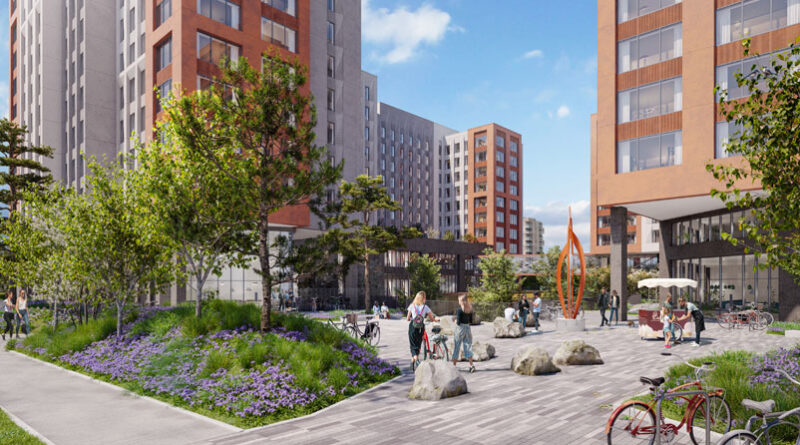Major Dublin student accommodation scheme gets the green light
An Bord Pleanála has granted planning for a major student accommodation scheme on the Naas Road, Dublin 12, which will bring much-needed student housing to the city.
Designed HKR Architects for Hollybrook Homes, the Gowan House development will provide 899 purpose-built student rooms (including 44 accessible units and 24 studios) across buildings varying in height from thirteen to ten storeys. The masterplan includes shared community and cultural space, retail space and an attractive public realm on the River Camac.
An Bord Pleanála overturned a previous refusal by Dublin City Council at Gowan House because student residential was not an appropriate use on the site and the mass of the proposal was inappropriately large.
Joao Ornelas, Associate Director for HKR Architects comments: “We welcome An Bord Pleanála’s decision to overturn a previous ruling by the Dublin City Council for this development, which brings 900 student beds to the city. The decision addresses the considerable pressure to supply student housing and creates a great opportunity for future regeneration within the City Edge masterplan.
“Our extensive PSBA experience together with our client’s long knowledge of the student sector has empowered the team to create a very viable and efficient scheme, achieving optimum site value in line with HKR’s well established ‘Value by Design’ ethos. This is something we pride ourselves on and bring to all our projects.
“This development is unique as it is one of the first to address the daylighting a culverted River in this case the Camac within the City Edge Strategic Framework. Opening a river running nine metres below ground level is challenging but will bring several benefits to the site and ultimately add value.”
Several innovative design measures were adopted to meet the project brief as well as address DCC’s policy aspirations. River daylighting was maximised, which in turn optimises the ecological benefit while providing a wonderful visual amenity to all the spaces overlooking the river.
The scheme includes extensive roof gardens as external amenities. This move in the landscape strategy allows the quantum of public realm to be increased, offering an interesting experience for the public with a treetop walk ‘floating’ over the river, providing an attractive visual and ecological feature to this new urban quarter. A pedestrian bridge connects the residential blocks, enabling the communal amenities to be shared between all blocks. This design has the operational benefit of a single entrance point from which residents are distributed across the dissected site.
The façade composition utilises complementary and contrasting colours to modulate the general mass of the scheme adding variety and interest to the overall composition. Pre-cast concrete components are proposed in the façade design, providing a high-quality finish with a considered of colour textures and patterns. This robust low maintenance material ensures the continued appearance of the façade through a full life cycle.
Prioritizing sustainable transportation, car parking provision is at an absolute minimum of nine spaces, including accessible parking. The development will improve the cycle network and offer extensive bicycle storage including cargo/adapted bike spaces and electric bike charging.
Follow Irish building magazine on LinkedIn for the latest news and updates

